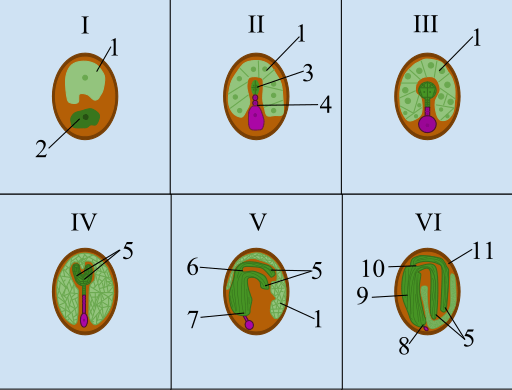Image: Seed Development Cycle

Description: Seed development in plants consists of six stages: Stage I - Zygote Stage After double fertilization, the endosperm and zygote are visible.
Stage II - Proembryo Stage The zygote divides to create a proembryo and a suspensor forms to transfer nutrients from the endosperm to the embryo allowing the embryo to grow.
Stage III - Globular Stage The proembryo contains numerous cells. The root-shoot axis is visible. The embryonic cells near the suspensor will form the root while the embryonic cells at the other end near the top of the embryo will become the shoot. There are cells on the outskirt of the embryo that will become the dermal tissue.
Stage IV - Heart Stage Cell division in the embryo creates a heart shaped embryo revealing the cotyledons.
Stage V - Torpedo Stage The root takes on a torpedo shape. The root and shoot apical meristems appear. Also present is the ground meristem. The cotyledons are clearly visible and start to bend.
Stage VI - Mature Embryo Stage The epicotyl, which contributes to the shoot, and hypocotyl, which contributes to the root, become visible along with the radicle. The cotyledons are extremely visible. Procambium can be seen at the core of the embryo. The integuments of the ovule become the seed coat. 1) Endosperm; 2) Zygote; 3) Embryo; 4) Suspensor; 5) Cotyledons; 6) Shoot Apical Meristem; 7) Root Apical Meristem; 8) Radicle; 9) Hypocotyl; 10) Epicotyl;
11) Seed Coat
Author: TheLAW14
Usage Terms: Creative Commons Attribution-Share Alike 3.0
License: CC-BY-SA-3.0
License Link: http://creativecommons.org/licenses/by-sa/3.0/
Attribution Required?: Yes
Image usage
The following page links to this image:

